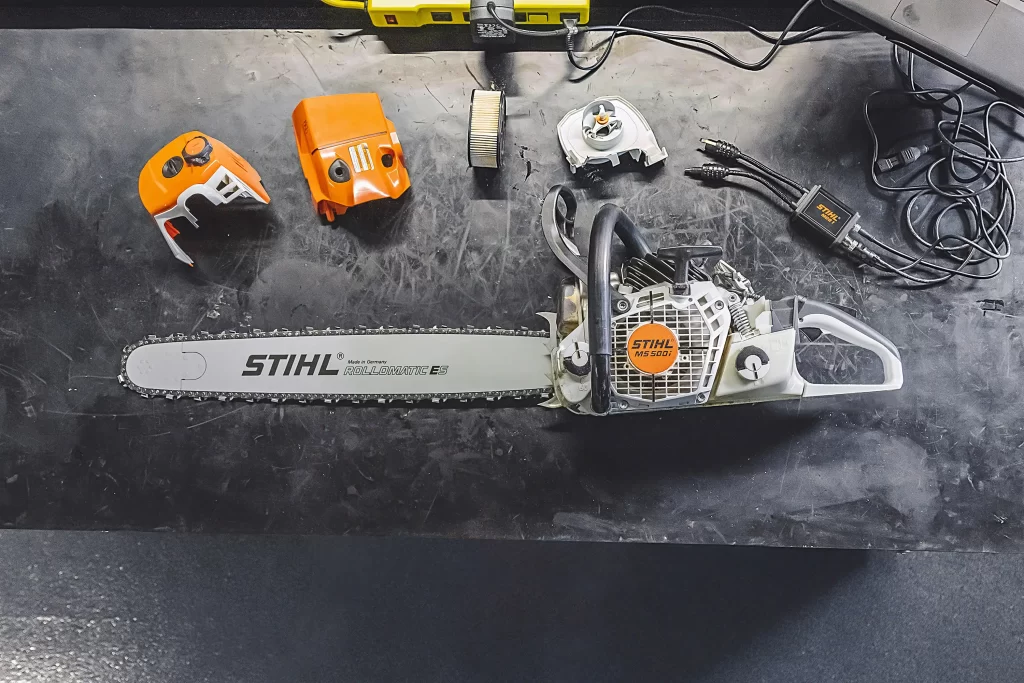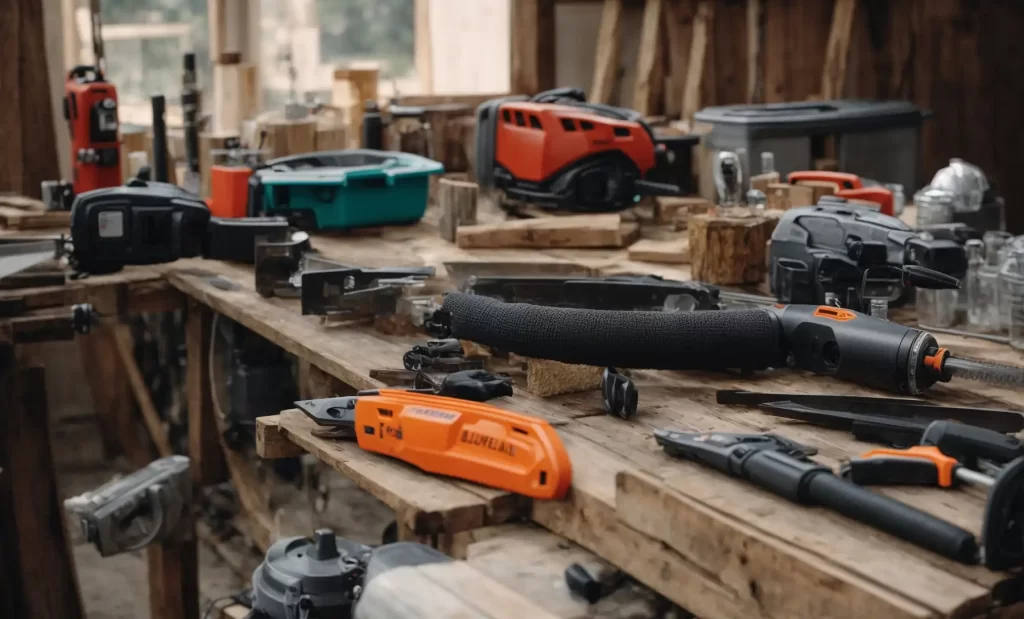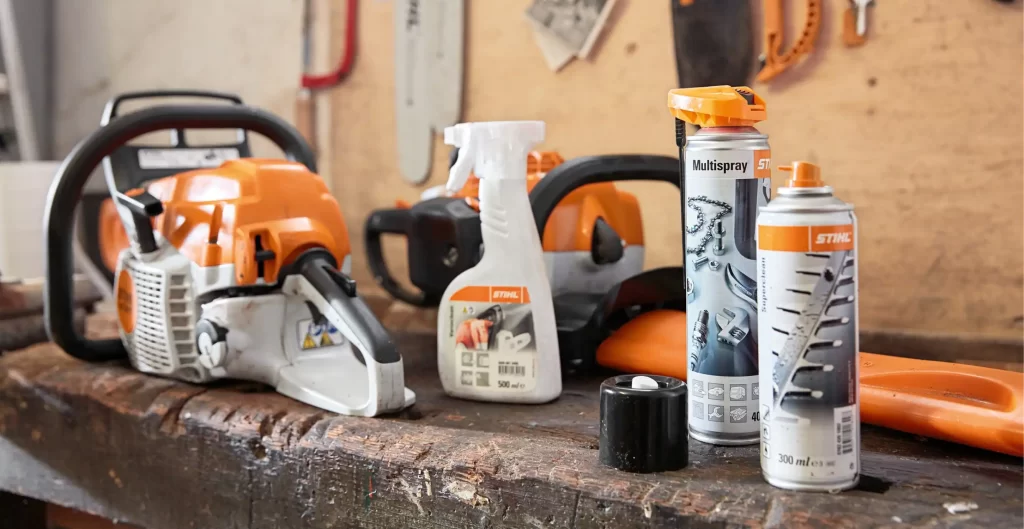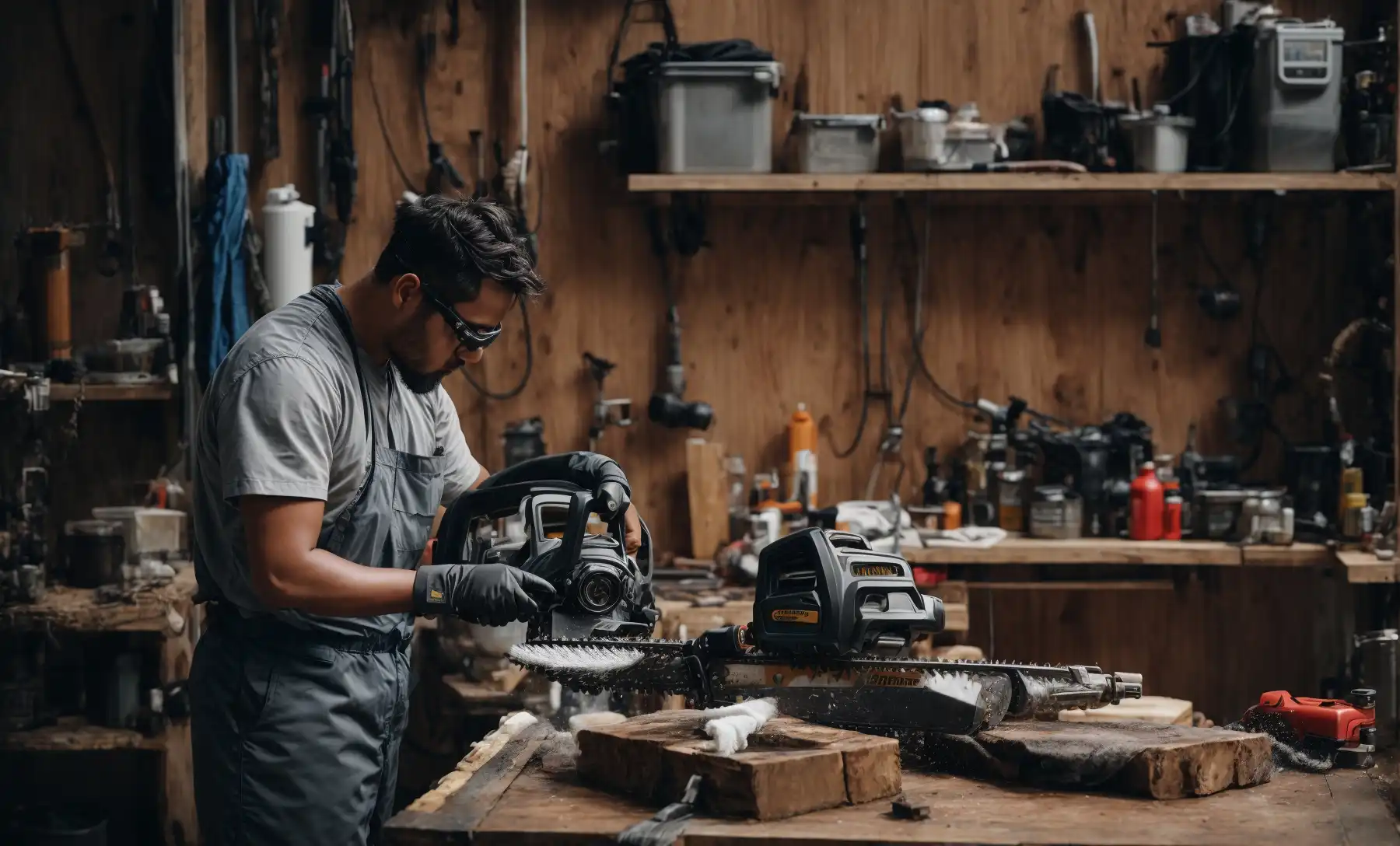To clean a chainsaw, remove the chain and guide bar, then brush off sawdust and debris. Use a mild detergent or degreaser for stubborn grime.
Ever wondered how to clean a chainsaw effectively? It’s not just a matter of aesthetics; it’s a vital practice for maintaining your chainsaw’s longevity and performance. Imagine your chainsaw, after a hard day’s work, caked in a stubborn mix of sap and sawdust.
This grime doesn’t just make your tool look untidy; it can also hinder its functionality. That’s where proper cleaning comes in. This guide will walk you through a comprehensive yet straightforward cleaning process, ensuring your chainsaw remains in top-notch condition. Ready to learn the ropes and keep your chainsaw running like new? Let’s get started.
Preparing for Chainsaw Cleaning
Ready to clean your chainsaw? First things first: preparation is key. In this section, we’re covering the essentials – safety measures and the tools you’ll need. From donning the right gear to gathering your cleaning arsenal, we’ve got you covered. This isn’t just about scrubbing off dirt; it’s about doing it safely and efficiently. Let’s get your workspace and yourself ready for a thorough chainsaw clean-up.

Safety First: Gear and Precautions
Safety can’t be overlooked. Before you touch your chainsaw, gear up. Put on sturdy gloves and safety goggles. These aren’t just accessories; they’re your defense against accidents. Now, make sure your chainsaw is off and completely cool. A hot engine not only poses a burn risk but also can make cleaning ineffective. Double-check that the power is off. It’s better to be safe than sorry.
Gathering Necessary Tools and Supplies
Got your gloves and goggles on? Great. Now for the tools. You’ll need brushes – soft for delicate parts, stiff for the tough grime. Grab some clean cloths too. They’ll come in handy for wiping off debris and applying solutions. Speaking of solutions, get a good chainsaw-specific cleaner. Harsh chemicals? Avoid them. They do more harm than good. And don’t forget lubricants – they’re crucial for post-cleaning maintenance. Now, with your tools and safety gear ready, you’re all set to start the cleaning process.

Step-by-Step: Way to Clean a Chainsaw
When it comes to understanding how to clean a chainsaw, a methodical approach is key. In this section, we’ll break down the cleaning process into manageable steps. From tackling the chain to sprucing up the guide bar and the body of the chainsaw, each part requires specific attention. We’ll guide you through removing, cleaning, and inspecting each component. This step-by-step method ensures your chainsaw not only looks good but operates at its best.
Cleaning the Chainsaw Chain
First up, the chain. Begin by carefully removing it from the chainsaw. This step is crucial for a thorough clean. Once removed, brush off any loose debris. Think of it as prepping the chain for a deeper clean. Next, it’s time for soaking and scrubbing. Immerse the chain in a cleaning solution designed for chainsaws. After soaking, use a brush to scrub off any remaining dirt. This process gets rid of the stubborn grime that a simple wipe can’t handle.
Cleaning the Guide Bar
Moving on to the guide bar. Start by removing all the dirt and sawdust that’s built up. A soft brush or cloth works well for this. Once it’s clean, inspect the bar for wear and damage. Look for signs like uneven wear or cracks. This step isn’t just about cleanliness; it’s also about ensuring the guide bar is in good working condition.
Cleaning the Chainsaw Body
Lastly, the body of the chainsaw. Wipe down the exterior with a damp cloth. Pay special attention to removing grime from crevices. Next, tackle the air filters. These are vital for the chainsaw’s performance. Clean or replace them as needed. Finally, inspect the body for any signs of damage. Look for cracks or loose components. Regular inspection can prevent potential failures during operation. With these steps, your chainsaw will not only be clean but also maintained for optimal performance.
Lubrication and Maintenance Post-Cleaning
After cleaning your chainsaw, the next crucial step is proper lubrication and maintenance. This section is dedicated to ensuring your chainsaw remains in peak condition after the cleaning process. We’ll cover how to select the right lubricant, the correct way to apply it, and the steps to reassemble your chainsaw. It’s not just about putting things back together; it’s about making sure your chainsaw operates smoothly and efficiently. Let’s dive into these post-cleaning rituals that are as important as the cleaning itself.
Proper Lubrication Techniques
Choosing the right oil for your chainsaw is crucial. Use a lubricant specifically designed for chainsaws to ensure optimal performance. Once you’ve got the right oil, it’s time to apply it. Focus on the chain and bar, as these parts require the most lubrication. Apply the oil evenly, ensuring every link and groove is covered. This not only reduces friction during operation but also prolongs the life of your chainsaw.
Reassembling the Chainsaw
Now, let’s put your chainsaw back together. Start by reattaching the chain and guide bar. Make sure the chain is seated properly in the bar’s groove and tensioned correctly. It shouldn’t be too tight or too loose. After attaching the chain, double-check all the components. Ensure everything is secure and in its right place. This step is crucial for safety and efficiency. A properly reassembled chainsaw not only works better but also reduces the risk of accidents. With these steps, your chainsaw is not just clean but also well-maintained and ready for action.
Additional Maintenance Tips
Beyond just knowing how to clean a chainsaw, regular maintenance is key to ensuring its longevity and performance. This final section focuses on establishing a maintenance routine and proper storage techniques. It’s not just about what you do while using the chainsaw, but also how you care for it when it’s not in use. These additional tips will help keep your chainsaw in top condition year-round.
Creating a Routine for Regular Maintenance Schedule
Setting up a regular maintenance schedule is essential for your chainsaw’s longevity. Like brushing teeth daily to avoid cavities, your chainsaw needs consistent attention. Here’s a simple timetable to follow:
| Frequency | Maintenance Task |
|---|---|
| After Each Use | Clean debris and check chain tension. |
| Weekly | Inspect and clean air filters. |
| Monthly | Check spark plug and clean sprocket area. |
| Bi-Annually | Service engine and replace worn parts. |
Establishing a maintenance schedule is crucial. Don’t wait until your chainsaw shows signs of wear or poor performance. Regular cleaning and servicing should be part of your routine. Aim to clean your chainsaw after every major use. For servicing, which includes checking and possibly replacing parts, a good rule of thumb is at least once a year. However, if you use your chainsaw more frequently, increase this frequency. Regular maintenance not only extends the life of your chainsaw but also ensures it’s safe to use every time.
Tips For Long-term Chainsaw Care
For a chainsaw that stands the test of time, think beyond basic cleaning. Here are some key care tips:
- Use fresh fuel and the correct oil mix to keep the engine healthy.
- Store in a dry, dust-free environment to prevent corrosion.
- Sharpen the chain regularly to maintain effective cutting.
- Inspect for loose or damaged parts before starting work.
Avoiding Common Cleaning Mistakes
Avoid the pitfalls that can lead to chainsaw damage. Follow these best practices when cleaning:
- Never clean a hot chainsaw. Always let it cool down first.
- Avoid using water on the chainsaw’s internal parts.
- Don’t forget to remove accumulated oil and sap from the guide bar groove.
- Be cautious with high-pressure air or water; it can force debris into bearings and seals.

Storage and Care Tips
Proper storage is as important as cleaning. Store your chainsaw in a dry, clean place to prevent rust and damage. Moisture is the enemy here, so avoid damp locations. If storing for an extended period, drain the fuel and oil to prevent corrosion and damage to the engine. Cover the chainsaw to protect it from dust and debris. These steps help in avoiding rust and keep your chainsaw ready for its next use. With these storage and care tips, you can ensure your chainsaw remains in excellent condition, ready for whenever you need it next.
Common Mistakes to Avoid in Chainsaw Cleaning
Cleaning a chainsaw might seem straightforward, but there are pitfalls to watch out for. This part of our guide shines a light on common mistakes made during the chainsaw cleaning process. By identifying these errors, we aim to help you avoid them, ensuring your cleaning routine is as effective and safe as possible. Let’s delve into these common oversights and learn how to steer clear of them for a flawless chainsaw maintenance experience.
List of Common Errors
- Ignoring Safety Precautions: Skipping safety gear like gloves and goggles is a big no-no. Always prioritize your safety.
- Cleaning a Hot Chainsaw: Attempting to clean your chainsaw immediately after use can be dangerous. Let it cool down first.
- Using Inappropriate Cleaning Agents: Harsh chemicals can damage your chainsaw. Stick to cleaners meant for chainsaws.
- Neglecting the Air Filter: The air filter is crucial for your chainsaw’s performance. Clean it regularly.
- Improper Lubrication: Failing to properly lubricate the chain and bar post-cleaning can cause premature wear.
- Forgetting to Check for Damage: Always inspect your chainsaw for damage during cleaning. Small issues can lead to bigger problems if ignored.
- Not Drying the Chainsaw After Cleaning: Leaving your chainsaw damp can lead to rust. Ensure it’s completely dry before storage.
How to Avoid Them
- Wear the Right Gear: Always put on your safety equipment before starting the cleaning process.
- Wait for the Chainsaw to Cool: Give your chainsaw ample time to cool down before you begin cleaning.
- Choose the Right Cleaners: Opt for cleaning solutions specifically designed for chainsaws.
- Regular Air Filter Maintenance: Clean or replace the air filter as part of your regular cleaning routine.
- Lubricate Thoroughly: After cleaning, apply the correct lubricant evenly across the chain and bar.
- Inspect During Cleaning: Use the cleaning process as an opportunity to check for any signs of wear or damage.
- Dry Completely: After cleaning, make sure your chainsaw is thoroughly dried to prevent rust.
By avoiding these common mistakes, you’ll ensure your chainsaw is not only clean but also well-maintained and ready for efficient, safe operation.
Know more: Can I Use 10W40 for Chainsaw Bar Oil
FAQs on Chainsaw Cleaning
How often should I clean my chainsaw?
Regular cleaning of your chainsaw should follow every major use. If you’re using it frequently, aim for a thorough clean after each significant project. This routine helps maintain its efficiency and prolongs its lifespan.
Can I use household cleaners on my chainsaw?
It’s best to avoid household cleaners for your chainsaw. They might contain harsh chemicals that can damage the chainsaw’s parts. Instead, use cleaners specifically designed for chainsaws to ensure safe and effective cleaning.
What are the signs of a chainsaw needing cleaning?
Signs that your chainsaw needs cleaning include visible debris build-up, decreased performance, unusual noises during operation, and increased difficulty in cutting. Regular checks for these signs can help maintain optimal chainsaw performance.
Conclusion
In wrapping up this guide on how to clean a chainsaw, let’s revisit the essence of what we’ve covered. Regular cleaning isn’t just about keeping your chainsaw looking good; it’s a critical practice for ensuring its longevity and optimal performance. Each step, from the initial preparation to the final maintenance checks, contributes to a well-functioning and reliable tool.
Remember, a clean chainsaw is a happy chainsaw. By following the steps outlined, you’re not only ensuring the efficiency of your equipment but also prioritizing your safety. Effective chainsaw maintenance goes a long way in preventing accidents and prolonging the life of your tool. So, take the time, follow these guidelines, and your chainsaw will be a steadfast partner in all your cutting tasks.
Rev up your chainsaw knowledge with Chainsaw Hive. In our Knowledge section, every article is a treasure trove of insights. Happy cutting and stay safe!
